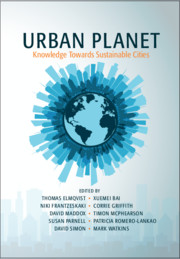In Gramscian terms, I believe in the role of the “organic intellectual” (Gottleib Reference Gottlieb1989). In Beuysian terms, I acknowledge an “extended concept of art” as was his idea of the Social Sculpture (Beuys Reference Beuys2004). However, these terms feel a little obscure or cultish for what I want to discuss here, even if they may be accurate, (art) historically speaking.
In considering the topic of urban sustainability – and specifically, how can we produce or coproduce knowledge that will propel the better cities of the future? – I think about a conspiracy between cultural production and dominant culture. I think of the instrumentalization of art and artists in the service of real estate agglomeration and the deadly perverse symbiosis of policy, such as “Quality of Life Enforcement” and the “Nuisance Abatement Action” (Goodman Reference Goodman2016) that can resultFootnote 1 when a city succumbs to what Sarah Schulman terms “The Gentrification of the Mind” (Schulman Reference Schulman2013).
In Representations of the Intellectual, Edward Said enumerates a set of pressures – or “impingements of modern professionalization” – he believed can “challenge the intellectual’s ingenuity and will.” These include specialization, attainment of expert status, and the “drift towards power and authority” (Said 1996: 82). His critique is not intended to challenge the acquisition of knowledge, but an observation that sometimes pedigreed “knowing” is best deployed in tandem with lay wisdom among its other forms. Shils (1959: 179) asserts “In every society … there are some persons with an unusual sensitivity to the sacred, an uncommon reflectiveness about the nature of the universe, and the rules which govern their society.” He is speaking of the intellectual in a way that can also describe the artist.
There is a double bind that serves to confuse the role of city building at the hands of nonexperts, the broader group to which artists are a subset when they go into residency at city agencies; are commissioned to make public art; and certainly when their interests and dedications become organically focused on social ills that societies encourage but fail to sustainably resource. This axis of obfuscation has traditionally rerouted the power of creativity (and perhaps what Said terms “ingenuity and will”) under or into a subservience to capital throughout recent history. This has the effect of leaving the artist in the “sacred man” predicament. In his seminal work Homo Sacer: Sovereign Power and Bare Life, Agamben (Reference Agamben1998) explains the original concept of homo sacer in Roman law, which is a person in the liminal state of being convicted of a crime not punishable by sacrifice (death), but who can be killed by a peer without the murder being considered homicide. He builds on the concept of homo sacer in order to show a contemporary society that maintains ambiguity through the use of positivist narratives, tropes, and wordplays may provide cover for maintaining the status quo.
Why do I put it in such harsh terms? It seems that the rhetoric of social practice art actually comes from the philanthropic fallout of the pan-Western subprime mortgage crisis that developed between 2007 and 2008. Raquel Rolnik, former UN Special Rapporteur on Adequate Housing and professor of architecture at the University of São Paulo, asserts that one important new development of social (specifically housing) movements is the expanding role of the cultural agent.Footnote 2 But the persistent loss of public money for art (as is typically the result of economic crises in a Western context) left a void. Into that void rushed a rhetoric of social art, social practice, creative place-making, artivism, and socially engaged art, as well as utilitarian and positivist sentiments. After the extreme and abrupt loss of culture funds, their replacement by “social art movements” was simply welcomed without being interrogated. Artists are faced with the double-bind of needing the social art money for their livelihoods, while also needing to critically engage the broader political economy in which they work: to understand and articulate the lived experience of precarity as a reality of neoliberal cultural production.
Cities need artists in the same way (or intensity) as Beuys suggests in a November 1969 interview in Artforum (Sharp Reference Sharp1969):
Art alone makes life possible – this is how radically I should like to formulate it. I would say that without art man is inconceivable in physiological terms.
A couple years ago, I was in a room full of grant-makers and philanthropists in which this question was asked: “How can we make sure that artists are as responsive to future natural disasters [as they were to Hurricane Sandy and the Calgary flooding]?” To which I reply: Art is as social as it has always been. Artists’ ideas are as vibrant as they have always been. However, to only pay attention to their societal function when faced with crises misses the point of art.
Is there a distinction between socially engaged art and just plain art? There is none. Does art produce knowledge? Of course – except when art merely supports a status quo.



